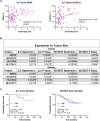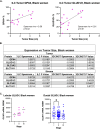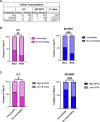This is a preprint.
Glutamate Transport Proteins and Metabolic Enzymes are Poor Prognostic Factors in Invasive Lobular Carcinoma
- PMID: 39464069
- PMCID: PMC11507668
- DOI: 10.1101/2024.09.29.615681
Glutamate Transport Proteins and Metabolic Enzymes are Poor Prognostic Factors in Invasive Lobular Carcinoma
Abstract
Invasive Lobular Carcinoma (ILC) is a subtype of breast cancer characterized by distinct biological features, and limited glucose uptake coupled with increased reliance on amino acid and lipid metabolism. Our prior studies highlight the importance of glutamate as a key regulator of ILC tumor growth and therapeutic response. Here we examine the expression of four key proteins involved in glutamate transport and metabolism - SLC3A2, SLC7A11, GPX4, and GLUD1/2 - in a racially diverse cohort of 72 estrogen receptor-positive (ER+) ILC and 50 ER+ invasive ductal carcinoma, no special type (IDC/NST) patients with primary disease. All four proteins are associated with increased tumor size in ILC, but not IDC/NST, with SLC3A2 also specifically linked to shorter overall survival and the presence of comorbidities in ILC. Notably, GLUD1/2 expression is associated with ER expression in ILC, and is most strongly associated with increased tumor size and stage in Black women with ILC from our cohort and TCGA. We further explore the effects of GLUD1 inhibition in endocrine therapy-resistant ILC cells using the small-molecule inhibitor R162, which reduces ER protein levels, increases reactive oxygen species, and inhibits oxidative phosphorylation. These findings highlight a potentially important role for glutamate metabolism in ILC, particularly for Black women, and position several of these glutamate-handling proteins as potential targets for therapeutic intervention in ILC.
Keywords: GLUD1; GPX4; Invasive lobular carcinoma; disparities; glutamate metabolism.
Conflict of interest statement
Conflict of interest: Authors declare no conflict of interest.
Figures






References
-
- Savir-Baruch B., Zanoni L. & Schuster D. M. Imaging of Prostate Cancer Using Fluciclovine. PET Clin 12, 145–157 (2017). - PubMed
Publication types
Grants and funding
LinkOut - more resources
Full Text Sources
Miscellaneous
